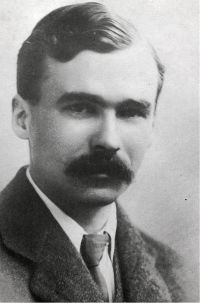George Butterworth
|
George Butterworth MC |
|
|---|---|

George Butterworth, c. 1914
|
|
| Born |
George Sainton Kaye Butterworth 12 July 1885 Paddington, London, England |
| Died | 5 August 1916 (aged 31) Pozières, The Somme, France |
| Cause of death | Shot by a sniper in the Battle of the Somme |
| Resting place | Unknown |
| Nationality | English |
| Education | |
| Alma mater | Trinity College, Oxford |
| Occupation | Composer, schoolmaster, music critic, professional morris dancer, soldier |
| Parent(s) | Sir Alexander Kaye Butterworth; Julia Marguerite Wigan |
| Relatives |
Joseph Butterworth (great great grandfather) Hugh Butterworth (cousin) |
George Sainton Kaye Butterworth, MC (12 July 1885 – 5 August 1916) was an English composer who was best known for the orchestral idyll The Banks of Green Willow and his song settings of A. E. Housman's poems from A Shropshire Lad.
Butterworth was born in Paddington, London. Soon after his birth, his family moved to Yorkshire so that his father Sir Alexander Kaye Butterworth could take up an appointment as general manager of the North Eastern Railway, based at York. George received his first music lessons from his mother, who was a singer, and he began composing at an early age. As a young boy, he played the organ for services in the chapel of his preparatory school, Aysgarth School, before gaining a scholarship to Eton College. He showed early musical promise at Eton, a 'Barcarolle" for orchestra being played during his time there (it is long since lost).
Butterworth then went up to Trinity College, Oxford, where he became more focused on music, becoming President of the University Music Club. He also made friends with the folk song collector Cecil Sharp; the composer and folk song enthusiast Ralph Vaughan Williams; the future Director of the Royal College of Music, Hugh Allen; and a baritone and future conductor, Adrian Boult. Butterworth and Vaughan Williams made several trips into the English countryside to collect folk songs (Butterworth collected over 450 himself, many in Sussex in 1907, and sometimes using a phonograph) and the compositions of both were strongly influenced by what they collected. Butterworth was also an expert folk dancer, being particularly keen in the art of morris dancing. He was employed for a while by the English Folk Dance and Song Society (of which he was a founder member in 1906) as a professional morris dancer, and was a member of the Demonstration Team.
...
Wikipedia
